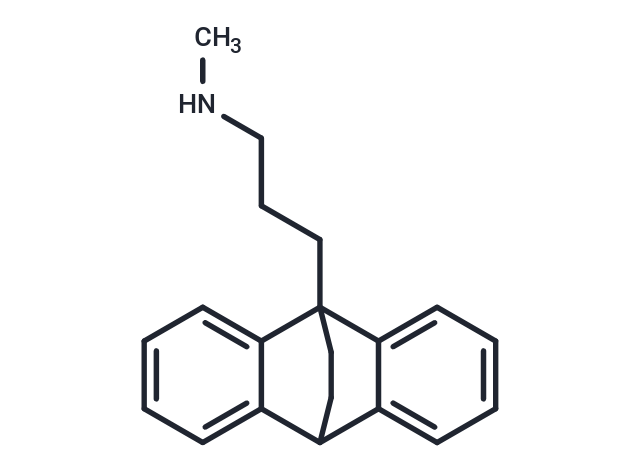Shopping Cart
Remove All Your shopping cart is currently empty
Your shopping cart is currently empty
Maprotiline inhibits cell proliferation and metastasis with anticancer effects. Maprotiline induces apoptosis in cancer cells by targeting ERK signaling pathway and CRABP1. Maprotiline is a highly selective norepinephrine reuptake blocker with potent antidepressant properties. [1][2].

| Pack Size | Price | USA Warehouse | Global Warehouse | Quantity |
|---|---|---|---|---|
| 25 mg | $1,520 | 1-2 weeks | 1-2 weeks | |
| 50 mg | $1,980 | 1-2 weeks | 1-2 weeks | |
| 100 mg | $2,500 | 1-2 weeks | 1-2 weeks |
| Description | Maprotiline inhibits cell proliferation and metastasis with anticancer effects. Maprotiline induces apoptosis in cancer cells by targeting ERK signaling pathway and CRABP1. Maprotiline is a highly selective norepinephrine reuptake blocker with potent antidepressant properties. [1][2]. |
| In vitro | Maprotiline, at concentrations of 10 μM, enhances the sensitivity of human hepatocellular carcinoma (HCC) cells, specifically Huh7 and HepG2 lines, to sorafenib (2 μM), leading to increased apoptosis. Additionally, maprotiline doses of 0, 10, or 20 μM administered for 72 hours target the ERK pathway, inhibit the phosphorylation of SREBP2, and possibly interact with CRABP1 to regulate cholesterol biosynthesis in these cells. Cell invasion assays demonstrate that maprotiline significantly curtails HCC cell migration and the process of epithelial-mesenchymal transition (EMT) at concentrations of 10 and 20 μM over 24 hours. In cell viability assays conducted over a range of 0 to 120 hours with similar concentrations, maprotiline dose-dependently and time-dependently induces apoptosis and reduces the viability of Huh7 and HepG2 cells. Western blot analysis further confirms the compound's role in inhibiting cholesterol biosynthesis within these HCC cells after a 72-hour exposure. |
| In vivo | Maprotiline, administered via intraperitoneal injection at doses of 3, 10, or 30 mg/kg, has been found to interact with the synthetic cannabinoid WIN 55,212-2, significantly alleviating neuropathic pain. Furthermore, when administered at doses of 0, 20, or 40 mg/kg twice weekly for three weeks, maprotiline exhibits low toxicity and minimal side effects on the organs, immune system, and hematopoietic function. At the same dosages and administration schedule, it also impedes cholesterol biosynthesis, thereby inhibiting the growth and metastasis of Hepatocellular Carcinoma (HCC) cells through its interaction with CRABP1. Studies on male Balb-c mice (25–30 g) showed a reduction in pain-related behaviors after treatment. In nude mice (BALB/C nu/nu, 4–6 weeks old, female), a 40 mg/kg dosage decreased serum and tumor cholesterol levels and curbed the growth of Huh7-derived tumor xenografts without significant toxic effects. |
| Molecular Weight | 277.4 |
| Formula | C20H23N |
| Cas No. | 10262-69-8 |
| Smiles | CNCCCC12CCC(c3ccccc13)c1ccccc21 |
| Storage | Powder: -20°C for 3 years | In solvent: -80°C for 1 year | Shipping with blue ice/Shipping at ambient temperature. |
| Size | Quantity | Unit Price | Amount | Operation |
|---|

Copyright © 2015-2026 TargetMol Chemicals Inc. All Rights Reserved.